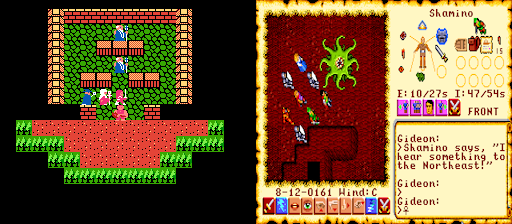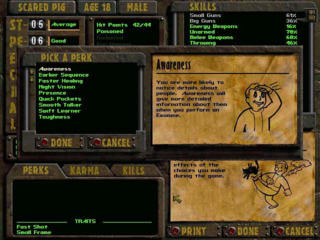Innovation of the Week: Manual Stat Allocation on Level Up
By alianger 1 Comments
This week, let's explore a classic mechanic that many RPG enjoyers but also Open World enjoyers tend to love: Manual Stat Allocation on Level Up. In the world of classic RPGs, the concept of manually allocating attribute or skill points upon leveling up adds a strategic layer to character development, while increasing the player's say in how their character develops, if not personality- or story arc-wise then at least stats-wise. It is also left in the player's hands through their entire adventure, not just during character creation if that exists. With this innovation, they can tailor their characters based on individual playstyles and preferences, or to fit a backstory they thought up and can tweak based on major events in the game so as to roleplay character development. It not only enhanced the roleplaying experience but also deepened the connection between players and their in-game avatars.

The roots of manual stat allocation seem to have begun growing in 1978 with the game Beneath Apple Manor (AII), a recurring game in this series. It's a groundbreaking Dungeon Crawler RPG and proto Rogue-like. While there is no character creation, players can distribute points across the attributes strength, intelligence, dexterity and "body" by trading in gained experience points that are rewarded for taking gold from chests. This simple yet revolutionary feature set the stage for future RPGs, although it's hard to say how influential this particular game was on future games besides Rogue.
Some More Retro Game Examples:

Ultima III (1983) and Ultima VI (1990) - The third Ultima included various interesting features for the time such as fast travel, avoidable encounters and tactical, top down view battles, and of course manual stat allocation. Stats are gained by going to Ambrosia and donating at the shrines there (in Ultima VI you also raise stats at shrines). Each shrine raises a specific attribute and each multiple of 100 gold donated will raise the respective attribute by one point. The maximum value each stat can have depends on the character's race. In Ultima VI, players also have to think about which shrines are the most useful to them and thus should be freed first as they are more spread out.

Zelda II (1987) - In the only Action RPG in the main Zelda series, Nintendo devised a fairly unique system which is deceptively simple. When leveling up, players can choose to increase either Life (defense), Magic (decreases the cost of spells) or Attack (damage dealt), and each requires a certain amount of experience points depending on the stat and which level they're currently at, where Attack is the most expensive to level. There is more nuance here however, as players can also choose not to level up a stat and save the points for later, focusing on one stat for several levels for example. Yet another layer is provided from the fact that canceling sets a pointer in the level up menu to a more expensive stat (after the most expensive it cycles back to the least expensive), and the shrines found after the boss of each temple fully level the player up. So if you canceled to set the pointer to the next stat, you also get more out of these level ups.
Ultima VII and Serpent Isle (1992/1993) - Here, gaining levels also grants training points – three points per level. These points can then be used in training sessions with the various trainers in the game to gain stats, and each trainer trains a number of attributes equal to the number of training points they require. The attributes that can be trained include the primary attributes of strength, dexterity and intelligence, alongside the secondary attributes of combat and magic (interestingly there is also a rubber band effect to combat based on how far below dexterity it is). You need a certain amount of training points to start training, but if a stat in question is already maxed out, then the point is not wasted, and instead returned to the pool of points.

Final Fantasy V (1992) - This one's a little different and more complicated to explain. By choosing to master specific jobs/classes (which level up through separate ability points rather than experience points and max out between levels 3-7), players have limited control over the gains on their main stats/attributes in that certain classes gain bonuses to certain stats but also a decrease to one or more stats. However, the default Freelancer (aka Bare) job gains all the highest stat increase(s) for mastered jobs to its job only, while any negative modifiers aren't applied, giving players detailed control over stat gains for each party member. That job also has two ability slots for choosing abilities gained through leveling up the different jobs, since they learn all of a job's innate abilities besides Berserk and don't need to equip them. For example it can inherently dash and see hidden passages (thief), avoid traps (geomancer) and wield two weapons in battle (ninja). There is also the Mime job, which works the same except it replaces the Fight and Item commands with a Mime one and has three empty ability slots, but can't equip Dancer gear such as ribbons.
Heroes of Might and Magic II-III (1996/1999) - Starting with the second game in this seminal SRPG series, players choose between two secondary skills at a time when leveling up, and they can also find NPCs that hand out a skill, sometimes as a quest reward. Skills include diplomacy which affects how likely neutral creatures are to join your army, logistics which affect movement on land, mysticism which increases MP regeneration per day and scouting which increases how far a hero can see on the overworld/adventure screen. The secondary skills can be upgraded two times each.

Fallout 1-2 (1997/1998): Fallout took the concept to a post-apocalyptic setting and elevated it to new heights for WRPGs, allowing players to customize their character's skills during character creation and through the leveling system. Three main skills are picked from a big list: three ranged+melee weapons as well as unarmed and throwing skills for combat, first aid, doctor, sneak, lockpick, steal, traps, science, repair, speech, barter, gambling and outdoorsman. Players can choose to strengthen their main skills or any of the other skills when leveling up and the amount of points they can distribute is determined by their Intelligence stat, but also Perks. Perks provide additional bonuses to stats and/or skills (oftentimes they can be upgraded twice as well), and the player gets to choose one of these every third level, increasing the customization of their build even further.
---
What are your favorite examples of this mechanic in retro RPGs and ARPGs? Which games handled it the best, or the worst? Share your thoughts and experiences!
